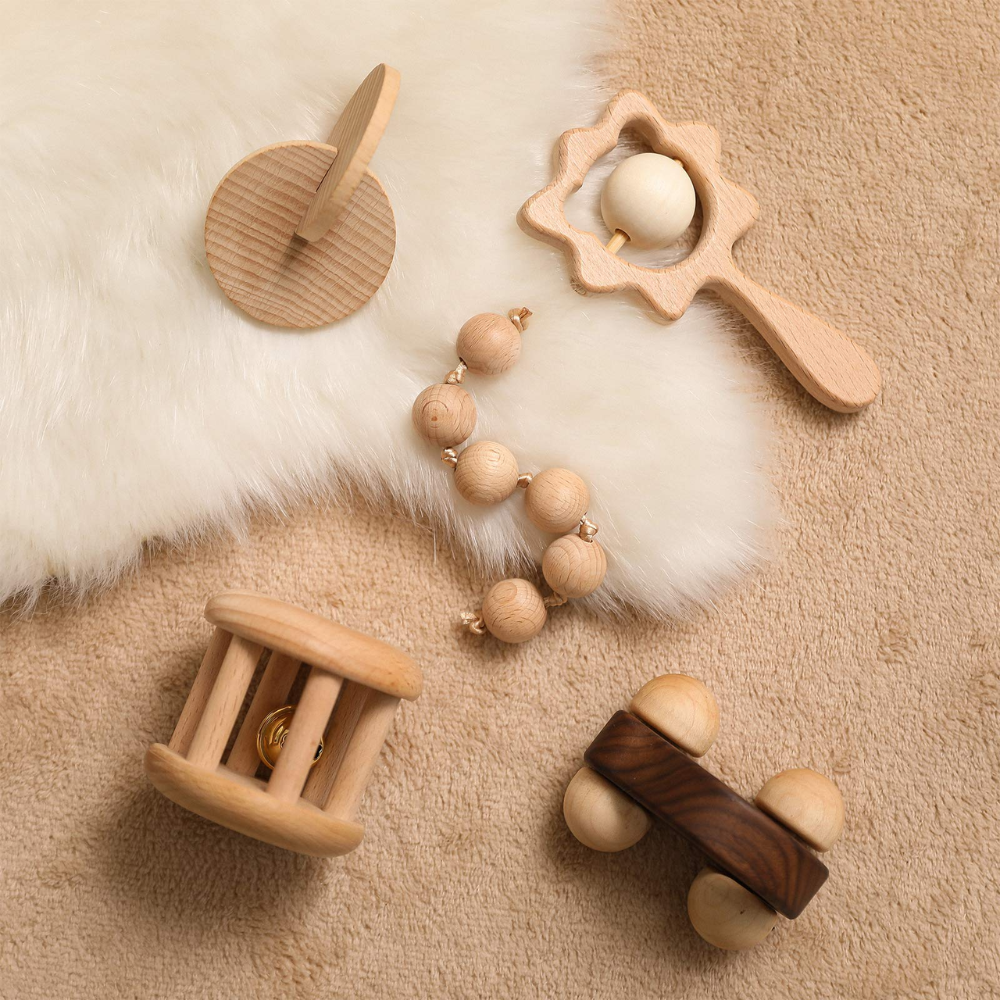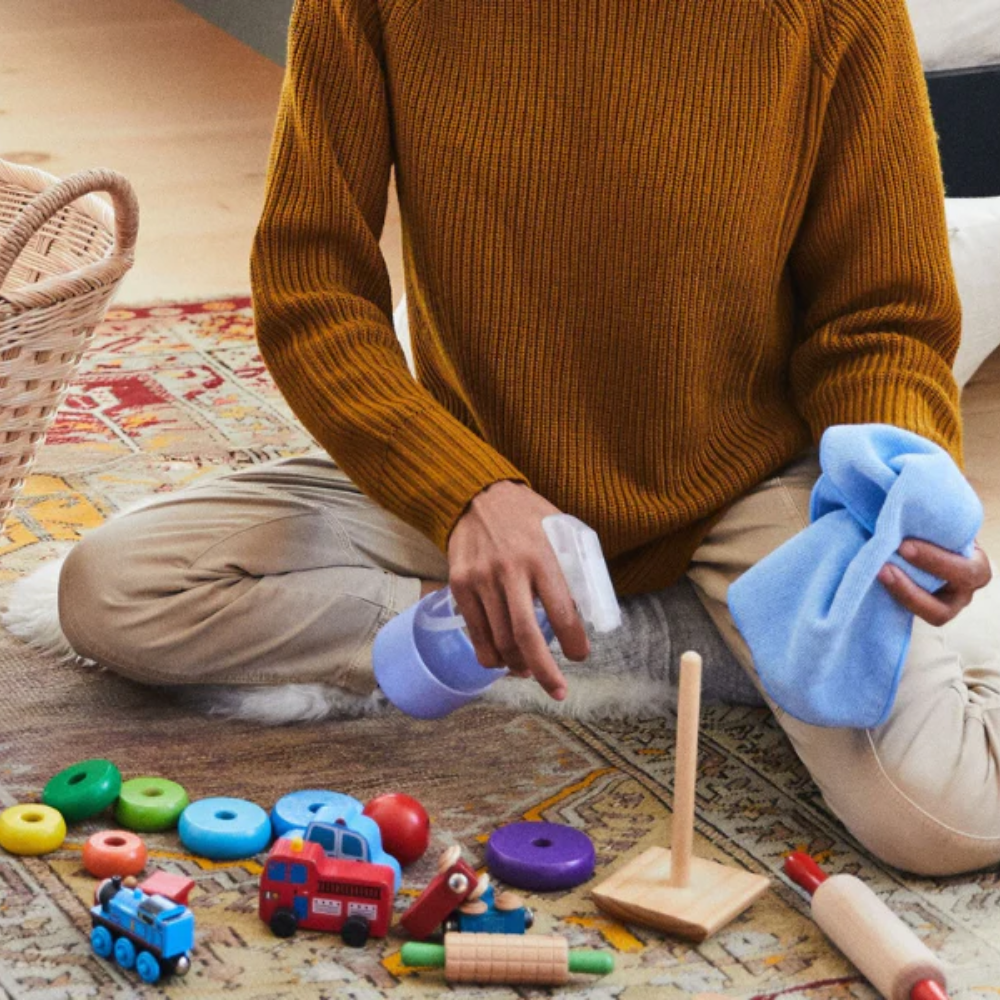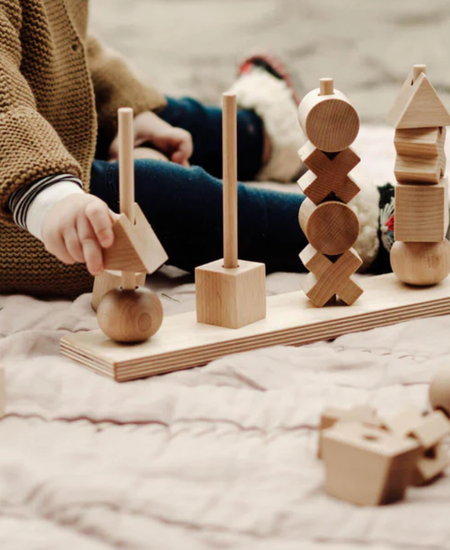Wooden baby toys are a timeless classic that has been around for generations. They are durable and long-lasting, and they provide endless opportunities for imaginative play and learning.
However, with constant use and exposure to drool and dirt, wooden baby toys can quickly become dirty and unhygienic. That's why it's essential to know how to properly clean them to keep your little one safe while playing.
In this guide, we'll discuss some simple yet effective ways to clean wooden baby toys, the importance of regular cleaning, and some additional tips for keeping them in top condition. These tips ensure that your child's favorite wooden toys stay safe and clean for years.
Why Is Cleaning Wooden Baby Toys Important?

Regular cleaning of wooden baby toys is crucial for maintaining their quality and ensuring your child's safety. Babies and young children are still developing their immune systems, making them more susceptible to germs and bacteria. Dirty toys can harbor harmful bacteria, leading to potential illness or infection if not properly cleaned.
Moreover, wooden toys are often used for teething, so they are likely to come into contact with saliva and other bodily fluids. These fluids can also attract dirt and bacteria, making it essential to clean the toys regularly.
Cleaning wooden baby toys keeps your child healthy and helps maintain the toy's appearance and durability. Without proper cleaning, they may become stained, develop an unpleasant odor, or even deteriorate. Regular cleaning can prevent these issues and prolong the lifespan of your child's beloved toys.
How To Clean Wooden Baby Toys

Cleaning wooden baby toys may seem daunting, but it is pretty simple and can be done with items you likely already have at home. Here are some easy steps to follow:
- Start by wiping down the toy with a damp cloth or baby wipe to remove any surface dirt or grime.
- For tougher stains or grime build-up, mix equal parts water and white vinegar in a spray bottle and spritz onto the toy's surface. Let it sit briefly before wiping it off with a clean cloth.
- For toys with intricate designs or hard-to-reach areas, use a toothbrush dipped in the vinegar solution to gently scrub away any dirt or grime.
- Rinse the toy thoroughly with water and dry it off with a clean towel.
- If your child's wooden toys have been in contact with bodily fluids, such as saliva or vomit, it is best to soak them in warm, soapy water for 10-15 minutes before rinsing and drying them.
- Lastly, let the toys air dry completely before returning them to your child.
- You can also use 1 part water and 1 part hydrogen peroxide for disinfecting purposes. Simply spray it onto the toy's surface and let it sit for a few minutes before wiping it off.
It is also important to note that not all wooden toys can be submerged in water, so always check the manufacturer's instructions before cleaning. For toys that cannot be washed, wiping them down with a vinegar solution or using a baby-safe disinfectant wipe is recommended.
Does the Type of Wood Matter?
The type of wood used in a baby toy can impact how it should be cleaned. Soft woods like pine are more porous and may need to be cleaned more frequently than denser woods like maple or beech. It is also essential to avoid using harsh chemicals or excessive water on wooden toys, as this can cause damage over time.
Additionally, if the toy has any painted areas, make sure to use gentle cleaning methods to avoid damaging the paint. Wooden toys with natural finishes should also be cleaned carefully, as abrasive cleaners can strip away the finish and leave the wood vulnerable to bacteria and mold growth.
Plus, always make sure to thoroughly dry the toy after cleaning to prevent any potential mold or mildew growth. And ensuring the toy is completely dry will also prevent any warping or cracking of the wood.
How To Choose The Right Types Of Baby Toy

Many types of baby toys are available on the market, but it's important to choose the right ones for your child. Here are some types of baby toys to consider:
Educational toys
Educational toys are designed to promote learning and development in young children. They can include puzzles, building blocks, shape sorters, and more.
These types of toys entertain and help improve hand-eye coordination, problem-solving skills, and cognitive development.
Plus, wooden educational toys are often made with non-toxic materials and have a natural texture that is safe for babies to explore with their hands and mouths.
Sensory toys
Sensory toys stimulate a baby's senses, including touch, sight, and sound. Wooden sensory toys like rattles or textured blocks can help with fine motor skills and hand-eye coordination while providing different textures for babies to explore.
Wooden teething toys
Wooden teething toys are popular for parents looking for safe and natural alternatives to plastic teethers.
They provide relief from teething discomfort while also being durable enough to withstand chewing. Plus, wooden teething toys are often made with non-toxic and chemical-free materials.
Soft toys
Soft toys are classic baby toys that provide comfort and companionship. They also come in various shapes, sizes, and textures, making them perfect for sensory play. When choosing soft toys for your child, make sure they are made with safe materials and are machine washable for easy cleaning.
You should consider These types of baby toys when shopping for your little one. Remember to always check for age-appropriate toys and follow proper cleaning methods, especially for wooden toys, to ensure your child's safety and enjoyment. So, choose wisely and have fun with your child as they explore and learn through play!
Does cleaning baby toys help prevent illness?

Yes, cleaning baby toys regularly is crucial for preventing illness and keeping your child healthy. Babies and young children are more susceptible to infections, so it's important to clean their toys often to remove any bacteria or viruses that may be present.
Bodily fluids like saliva and vomit can pass on germs and attract dirt, making it essential to clean these toys frequently. Additionally, wooden toys can easily accumulate dirt and grime over time, which can harbor harmful bacteria if not cleaned properly.
Moreover, some babies may habitually put everything in their mouths, including their toys. By cleaning these toys regularly, you can also prevent your child from ingesting any harmful substances or bacteria that may be present on the toy's surface.
Following proper cleaning methods can reduce the risk of your child getting sick and promote a healthier environment for them to play in. So, make sure to incorporate regular toy cleaning into your daily routine to keep your little one happy and healthy.
FAQs
How should I clean wooden toys compared to plastic toys?
When you clean wooden toys, treating them differently from plastic toys is important. Wooden toys should be wiped down with a damp cloth and not soaked in water, as too much moisture can damage the wood. Unlike plastic toys, which can often be submerged, wood toys require a gentler cleaning method.
What is the best way to wash wooden toys without damaging them?
The best way to wash wooden toys is to use a solution of warm water and mild dish soap. Dip a soft brush or cloth into the soapy water and gently scrub the wooden toy. Remember, it’s important to clean them with care and not soak the wood, as excess water can cause warping or cracking.
Can I use a mild dish soap to clean wooden toys?
Yes, you can use mild dish soap to clean wooden toys. Mix the soap with warm water, and use a soft brush to scrub the wooden blocks or other wooden toys gently. This cleaning method is effective and safe, ensuring that the toys are clean without damaging the wood.
Should I soak wooden blocks when I clean them?
No, it would be best not to soak wooden blocks or wooden toys when cleaning them. Soaking can cause it to be best if you do not want to swell, warp, or crack. Instead, clean wooden toys with a soft brush, a solution of warm water, and mild dish soap, and wipe them down thoroughly.
What cleaning method should I use to clean wooden toys like wooden blocks?
To clean wooden toys, including wooden blocks, use a cleaning method that involves a mixture of warm water and mild dish soap. Apply this solution with a soft brush, and make sure not to soak the wood. After cleaning, wipe the toys dry to prevent any water damage.
Is it safe to wash wooden toys with water?
It is safe to wash wooden toys with water, but it’s important to use warm water and not soak the wood. Use a soft brush and mild dish soap to clean the toys gently. This method ensures that the wooden toy remains in good condition while being cleaned effectively.
Conclusion
In conclusion, cleaning baby toys is an essential part of keeping your child safe and healthy. It's important to choose the right types of toys for your child, such as educational or sensory toys, wooden teething toys, and soft toys.
Regularly cleaning these toys can prevent the spread of germs and bacteria that can cause illness. Make sure to use gentle methods when cleaning wooden toys to avoid damaging them, and always thoroughly dry them afterward.
By incorporating regular toy cleaning into your routine and choosing age-appropriate and safe materials, you can promote a clean and healthy environment for your child to play in. Remember to also check for any manufacturer instructions on how to properly clean and care for specific toys.
Subscribe to our email newsletter and unlock access to members-only content and exclusive updates.

Comments